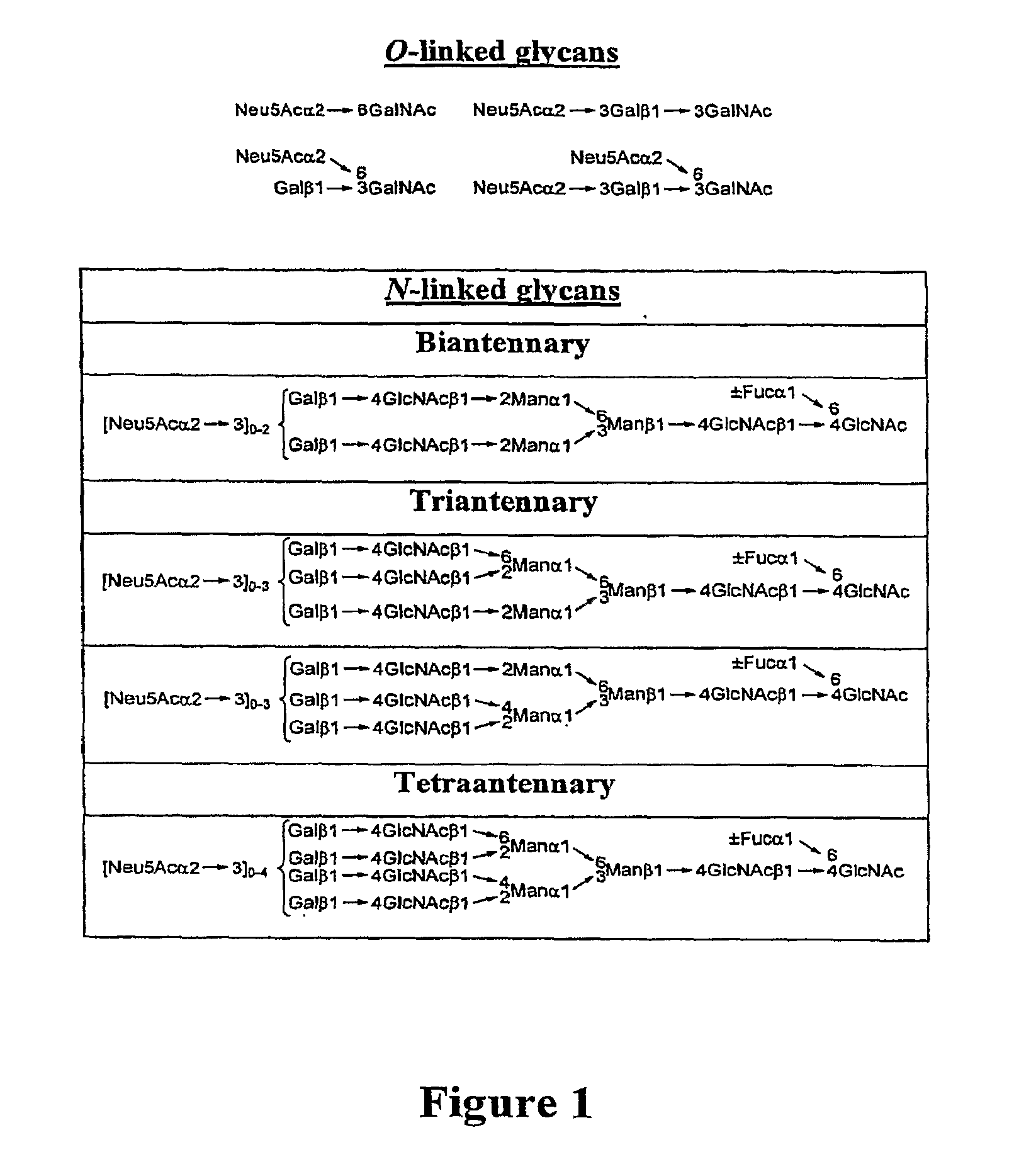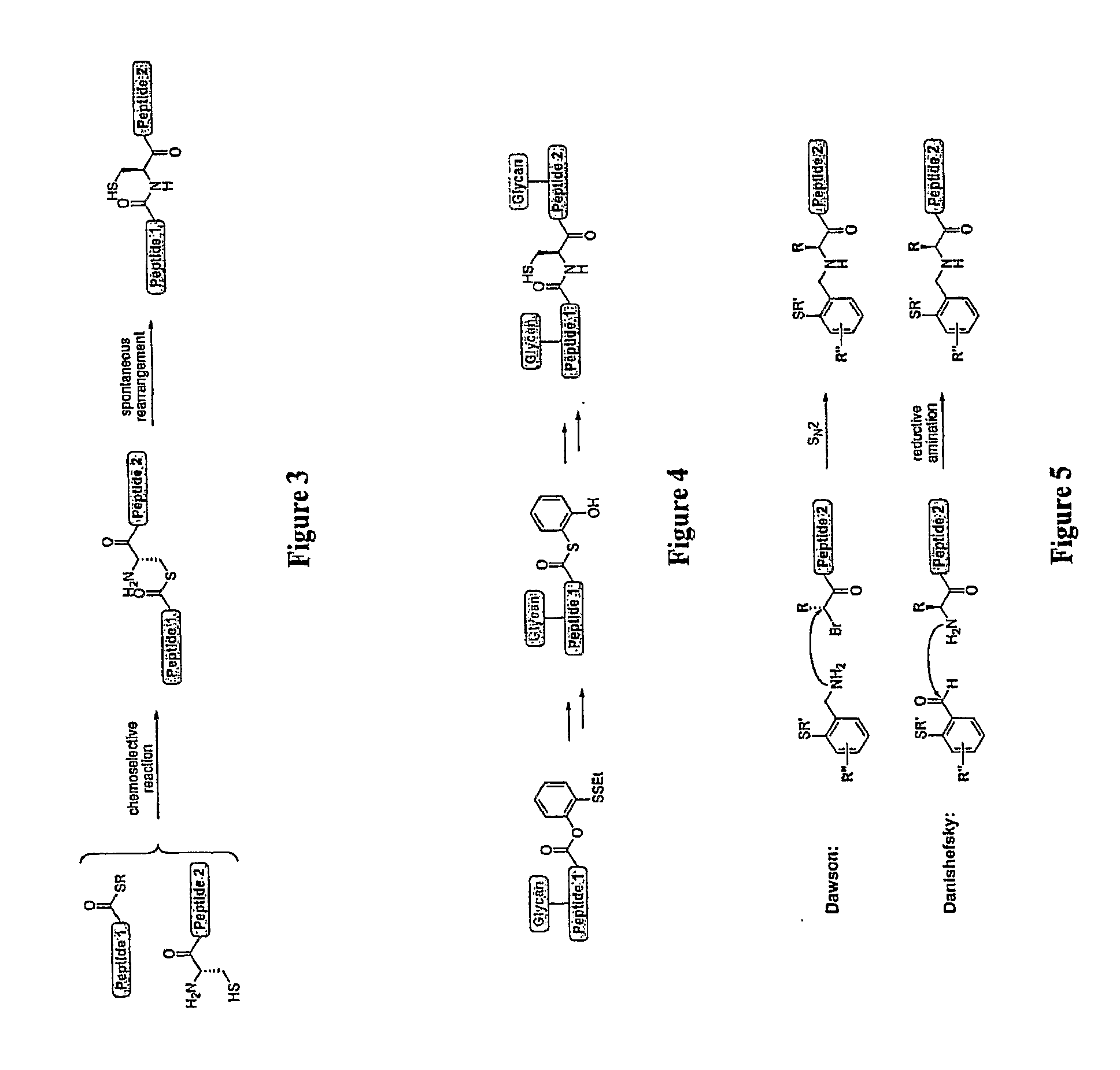Homogeneous Erythropoietin and Other Peptides and Proteins, Methods and Intermediates for Their Preparation
- Summary
- Abstract
- Description
- Claims
- Application Information
AI Technical Summary
Benefits of technology
Problems solved by technology
Method used
Image
Examples
example 1
Synthesis of Peptidic Fragments of Erythropoietin Using Secondary Amino Acid Surrogates
[0536]In this example, we describe an efficient and general method for the generation of complex peptidic fragments, possessing a C-terminal phenolic ester and / or a N-terminal auxiliary. These peptidic fragments can then be merged with an oligosaccharide unit and / or small glycopeptide to provide the desired glycopeptide segments.
Results
[0537]We started from the synthesis of the peptidic fragment, EPO(78-113), a 36-amino acid polypeptide chain with a N-terminal auxiliary and a C-terminal phenolic ester. In particular, this fragment contains 17 hydrophobic residues, which is more than 47% of the sequence. The synthesis of fully-protected EPO(78-113) was initially carried out under our standard laboratory conditions with resulting low crude purities of less than 10% obtained. Subsequent dissolving and purification of the peptide to high purity proved difficult. Confirmation of the parent peak by LC-M...
example 2
Mature Homogeneous Erythropoietin Building Blocks by Chemical Synthesis: The EPO 22-37 Glycopeptide Domain Presenting the Fully N-Linked Dodecasaccearide
[0553]In an earlier publication directed to the erythropoietin (EPO) problem, we related the synthesis of the protected biantennary dodecamer glycan 4 (Wu et al., Tetrahedron Lett. 2006, 47, 5577-5579). The synthesis commenced with the preparation of hexasaccharide (2) and trisaccharide (3), through recourse to glycal assembly methods developed in our laboratory and through application of the Crich-Kahne direct mannosylation protocol (Danishefsky et al., Angew. Chem. Int. Ed. 1996, 35, 1380-1419; Danishefsky et al., Angew. Chem. Int. Ed. 2000, 39, 836-863; Crich et al., J. Org. Chem. 1997, 62, 1198-1199; Crich, D.; Sun, S. Tetrahedron 1998, 54, 8321-8348; Kahne et al., J. Am. Chem. Soc. 1989, 111, 6881-6882). Under Sinay radical cation activation conditions, coupling of 2 with excess amounts of 3 successfully provided the fully prot...
example 3
Mature Homogeneous Erythropoietin-Level Building Blocks by Chemical Synthesis: The EPO 114-166 Glycopeptide Domain, Presenting its O-Linked Glycophorin
[0565]The naturally occurring glycoprotein, erythropoietin (EPO), is a 166-residue protein possessing four carbohydrate domains (Lai et al., E. J. Biol. Chem. 1986, 261, 3116-3121). The synthesis of the EPO 22-37 fragment displaying the mature N-linked dodecasaccharide domain has been described (Wu et al., Tetrahedron Lett. 2006, 47 Proceeding Communication). Herein, we describe the synthesis of the EPO 114-166 glycopeptide, presenting the glycophorin glycan at Ser126 (1).
EPO 114-166 Glycopeptide (1).
[0566]A synthetic plan toward erythropoietin with a view toward optimal convergency was developed. The program would entail synthesis of the required peptide fragments, each of which would be equipped with a mature carbohydrate domain. These glycopeptides would then be merged by exploiting chemical ligation methods developed elsewhere (Of...
PUM
| Property | Measurement | Unit |
|---|---|---|
| Fraction | aaaaa | aaaaa |
| Composition | aaaaa | aaaaa |
| Structure | aaaaa | aaaaa |
Abstract
Description
Claims
Application Information
 Login to View More
Login to View More - R&D
- Intellectual Property
- Life Sciences
- Materials
- Tech Scout
- Unparalleled Data Quality
- Higher Quality Content
- 60% Fewer Hallucinations
Browse by: Latest US Patents, China's latest patents, Technical Efficacy Thesaurus, Application Domain, Technology Topic, Popular Technical Reports.
© 2025 PatSnap. All rights reserved.Legal|Privacy policy|Modern Slavery Act Transparency Statement|Sitemap|About US| Contact US: help@patsnap.com



